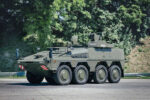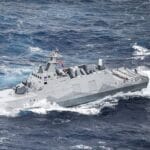At the Association of the United States Army (AUSA) Annual Meeting 2025 in Washington D.C., Israeli defense firm RAFAEL Advanced Defense Systems unveiled its operational prototype of the Iron Beam high-energy laser weapon system. Designed to intercept UAVs, rockets, mortars, and artillery shells within a 10 km range envelope, Iron Beam represents a significant milestone in the maturation of directed energy weapons for tactical air defense.
Iron Beam Overview: Tactical High-Energy Laser for C-RAM and SHORAD
Iron Beam is a ground-based high-energy laser (HEL) system developed by RAFAEL to provide close-range air defense against low-cost aerial threats. It complements kinetic systems like Iron Dome by offering a cost-effective solution to defeat saturation attacks involving drones (UAS), rockets (C-RAM), mortars, and artillery shells. The system uses a solid-state fiber laser reportedly in the 100–150 kW class—sufficient to thermally neutralize small projectiles or drone airframes within seconds of beam contact.
The primary engagement envelope is estimated at up to 10 km against Class I/II UAVs and short-range indirect fire threats. Unlike kinetic interceptors such as Tamir missiles ($50K–$100K per shot), Iron Beam offers near-zero cost per shot after deployment—limited primarily by electrical power availability and thermal management constraints.
System Architecture and Integration with Multi-Layered Air Defense
Iron Beam is designed as part of Israel’s multi-layered air defense architecture. It operates below systems like David’s Sling (medium-range) and Arrow (long-range BMD), and alongside Iron Dome for short-range threats. The HEL unit includes:
- A mobile laser turret mounted on a tactical truck or trailer platform
- Electro-optical tracking sensors with automatic target acquisition
- A beam director with adaptive optics for atmospheric compensation
- Power generation module (diesel or hybrid-electric)
- C2 interface compatible with Israeli C4I systems including Sky Dew aerostat radar feeds
The system can be cued via radar or EO/IR sensors integrated into national or tactical networks. During testing phases conducted jointly by RAFAEL and Israel’s Directorate of Defense Research & Development (DDR&D), Iron Beam successfully intercepted multiple UAVs and simulated mortar shells under operational conditions.
AUSA Debut Signals Export Intentions Beyond Israeli Service Entry
While RAFAEL has been developing Iron Beam since at least 2014—with accelerated efforts following increased rocket attacks from Gaza—the AUSA debut marks the first formal presentation of an export-ready configuration aimed at U.S. partners. According to RAFAEL officials at the expo booth, the system is being pitched as a complementary layer for allied nations seeking affordable counter-UAS/C-RAM solutions without reliance on expensive missile stocks.
The U.S. Army has expressed growing interest in directed energy weapons under programs such as IFPC-HEL (Indirect Fire Protection Capability – High Energy Laser) and DE M-SHORAD (Directed Energy Maneuver-SHORAD). While Lockheed Martin’s HELSI-based DE M-SHORAD platform is already undergoing fielding trials with Stryker-mounted lasers in the U.S., foreign systems like Iron Beam may offer alternative architectures for fixed-site or semi-mobile base defense roles.
Operational Readiness Timeline and Deployment Plans
As of late 2024, Israeli Prime Minister Benjamin Netanyahu confirmed that initial operational capability (IOC) was expected “within months.” In April–May testing cycles conducted in southern Israel under live-fire conditions, Iron Beam demonstrated successful engagements against multiple targets launched simultaneously—suggesting readiness for real-world deployment during high-volume threat scenarios.
The IDF plans to integrate Iron Beam into its active air defense grid starting in late Q1 or early Q2 of FY2025. Initial deployments are expected around strategic infrastructure sites vulnerable to drone swarms or rocket saturation attacks—especially near Gaza or northern borders facing Hezbollah’s arsenal.
Tactical Implications: Cost Curve Disruption in Air Defense
The most disruptive feature of Iron Beam lies not only in its physics but also its economics. Traditional C-RAM systems rely on expensive interceptors with limited magazine depth; lasers offer theoretically unlimited shots constrained only by power supply and maintenance cycles.
- Cost per shot: Estimated <$10 per firing event vs $50K+ interceptor costs
- Sustainability: No reload logistics; continuous operation possible with generator support
- Lethality: Effective against unarmored drones/shells; less effective vs maneuvering cruise missiles or hardened targets
This makes HEL systems particularly attractive for counter-drone missions where adversaries deploy large numbers of cheap quadcopters or loitering munitions—a tactic increasingly used by non-state actors and peer competitors alike.
Challenges Ahead: Atmospheric Effects & Power Scaling
Despite progress toward IOC status, high-energy lasers face inherent limitations:
- Weather sensitivity: Fog, rain, dust reduce beam effectiveness due to scattering/absorption
- Cooled optics: Thermal management remains critical under sustained fire conditions
- Power draw: Requires high-output generators; limits mobility unless hybridized platforms are used
RAFAEL has reportedly invested heavily in adaptive optics technologies to mitigate beam distortion over long ranges. However, performance degradation under adverse weather remains an open challenge shared across all HEL developers globally—including Lockheed Martin’s ATHENA/HELIOS programs and Rheinmetall’s Skyranger HEL variant.
The Road Ahead: Export Potential & Strategic Impact
If proven reliable under combat conditions—and scalable across platforms—Iron Beam could shift procurement strategies among NATO allies seeking affordable SHORAD/C-RAM options amid drone proliferation. Countries like Poland, Romania, India, South Korea have all expressed interest in integrating directed energy into their layered defenses.
The U.S.–Israel bilateral cooperation framework may also facilitate technology sharing or co-production arrangements if DoD requirements align with RAFAEL’s roadmap—particularly if budget constraints push demand toward low-cost-per-shot solutions over traditional missile-centric architectures.










